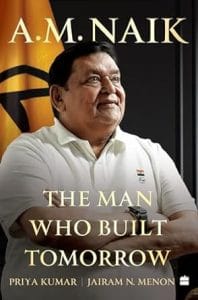A.M. Naik has seemingly done it all. He dreamed big, and is among the fortunate few who have been able to translate into reality much of what he dreamed.
As an industrialist, he orchestrated a transformation process that charted a bold new course for one of India’s most admired companies, and enabled it to touch heights never attained before. The mantelpiece in his offices in both Powai and Andheri are filled with gleaming metal, tassels and congratulatory bric-a-brac. He has received almost all the awards one could wish for, including high national honours.
As a philanthropist, his outcome-oriented approach is making a tangible difference to the lives of thousands.
So why can’t we have more like him? How wonderful it would be if, as Dr Prathap C. Reddy of Apollo Hospitals once said, we had 100 A.M. Naiks?
We tried to separate the accomplishments from the achiever to decode his multi-dimensionality and find the answer to what makes Naik the man who built tomorrow.
Macro and Micro
Some people believe that dreaming and doing are mutually exclusive. You can either be good at viewing everything from 40,000 feet, or you can bend over and study life through a microscope. Naik breaks the mould—he looks at the big picture and sees the
brushstrokes too. This has been widely acknowledged by his peers.
For Naik, plans are pointless unless they are backed by demonstrable means to achieve them. In November 2017, at the launch of his biography The Nationalist, Reliance Industries chairman Mukesh Ambani underscored the point by saying: ‘Vision without implementation is illusion.’ Naik is too grounded, too level-headed, to remain under an illusion for any length of time.
He compels himself, and his team, to ensure that his vision goes through the grind—the shaping, bending and honing essential for it to emerge as reality.
How micro can you get? Naik will go down to the last decimal. No statistic and no long-term implication of a current transaction escapes his attention. He can recollect from memory the financial details of almost all the businesses within the company. He is not a visionary who will let others get into the granular details—he doesn’t leave much number-crunching to others because he is a master at it.
Confirmation comes from an authoritative source—Subodh Bhargava, industry chieftain and a former director on the L&T board. Bhargava told us how impressed he was at his very first meeting with Naik. At that time, Bhargava was an independent director with Wartsila, the global power solutions company for the marine and energy markets. They were exploring the prospects of supplying engines for L&T’s shipbuilding business. ‘Naik came personally prepared for the meeting,’ says Bhargava. ‘He had all the details. Although his entire senior team was also present, they didn’t have to be brought into the discussion at all.’
Alongside the ability to straddle both the macro and the micro, leaders have the ability to switch their minds and attention from one subject to another. Naik shifts gears without so much as a blip in conversation. He can be handling one business matter intensely one minute and switch effortlessly to another business or to a totally unconnected issue. From hydrocarbon engineering to CSR, branding to finance, corporate strategy to construction machinery—and each of them receives 100 per cent of his attention.
Speaking your mind
We live in a world of pleasant noises, right notes and political correctness. You are not expected to say what you feel or express your opinion. Euphemism is the lingua franca of the corporate world, and the higher you go up the ladder, the worse it gets.
Naik is an outlier, known to be blunt. Even when talking to the media, with its fearsome reputation for amplifying the slightest misstep, Naik does not hold back. This has become widely accepted, and the media even has a word for it: ‘Naik-speak’. It has many advantages, like telling you exactly where you stand, and saves time and energy because he doesn’t waste them trying to sugar-coat his responses. It’s either a yes or a no, often with the emphasis one would textually represent in capital letters.
He told us that if there was something to be said, even if it was going to cause some immediate unpleasantness, he would go ahead and say it. ‘Otherwise, I feel it’s a burden on me.’
As Noshir Kaka from McKinsey put it in conversation with us, ‘Mr Naik has no filter.’
Doing things differently
‘We are prisoners of our legacies,’ said R. Shankar Raman, L&T’s CFO, blessed with a unique gift: being quick with numbers and felicitous with words. ‘We are used to doing things in a certain way and begin to believe that it is the only way to do it.’
Naik, he said, does not subscribe to past practice or precedents. According to Shankar Raman, Naik believes that if things have been done in a particular way for a long time, it’s an excellent reason to change things around. So when new ways of thinking begin to gain ground, the shackles of yesterday are broken; you find you can do more, do it better and faster. That’s how Naik was able to be outrageous in his targets and expectations.
When Naik gave you a deadline, you would say to yourself, ‘This is ridiculous. How is this even possible?’ But then, seven or eight times out of ten, the tasks get completed. ‘Those outrageous targets compelled us to find innovative solutions,’ said Shankar Raman, ‘which were always there, but were, so to speak, hiding in plain sight.’
Scale of ambition
This is a term we have borrowed from Noshir Kaka. As a leading global management consultant, Kaka has a ringside view of the head honchos of some of the top companies in the world. He is privy to their thought processes; he can anticipate how they will react to a given situation; he knows what makes them tick. But he is clearly impressed with many of the striking characteristics of Naik. One of them is the awesome scale of his ambition. To use cricketing parlance, where most batsmen would be content playing a defensive shot, Naik would step out of the crease and aim for a six!
Decades ago, when a Supreme Court resolution made it mandatory for refineries to upgrade their systems, it opened up a large canvas for Indian manufacturers. Naik aimed big, and L&T got on to executing clean fuel systems at eight refineries simultaneously, all over the country. Observers across the industry said it would be impossible for a single company to do it, but Naik believed that it could be done and then proceeded to rally his team to make the impossible possible. This scale of ambition is also the propulsion power behind L&T’s speedy growth in recent years.
‘Dream no small dreams,’ Johann Wolfgang von Goethe had said, ‘for they have no power to move the hearts of men.’ Naik would wholeheartedly agree.
 This excerpt from ‘A. M. Naik: The Man Who Built Tomorrow’ by Priya Kumar and Jairam N. Menon has been published with permission from HarperCollins Publishers.
This excerpt from ‘A. M. Naik: The Man Who Built Tomorrow’ by Priya Kumar and Jairam N. Menon has been published with permission from HarperCollins Publishers.






